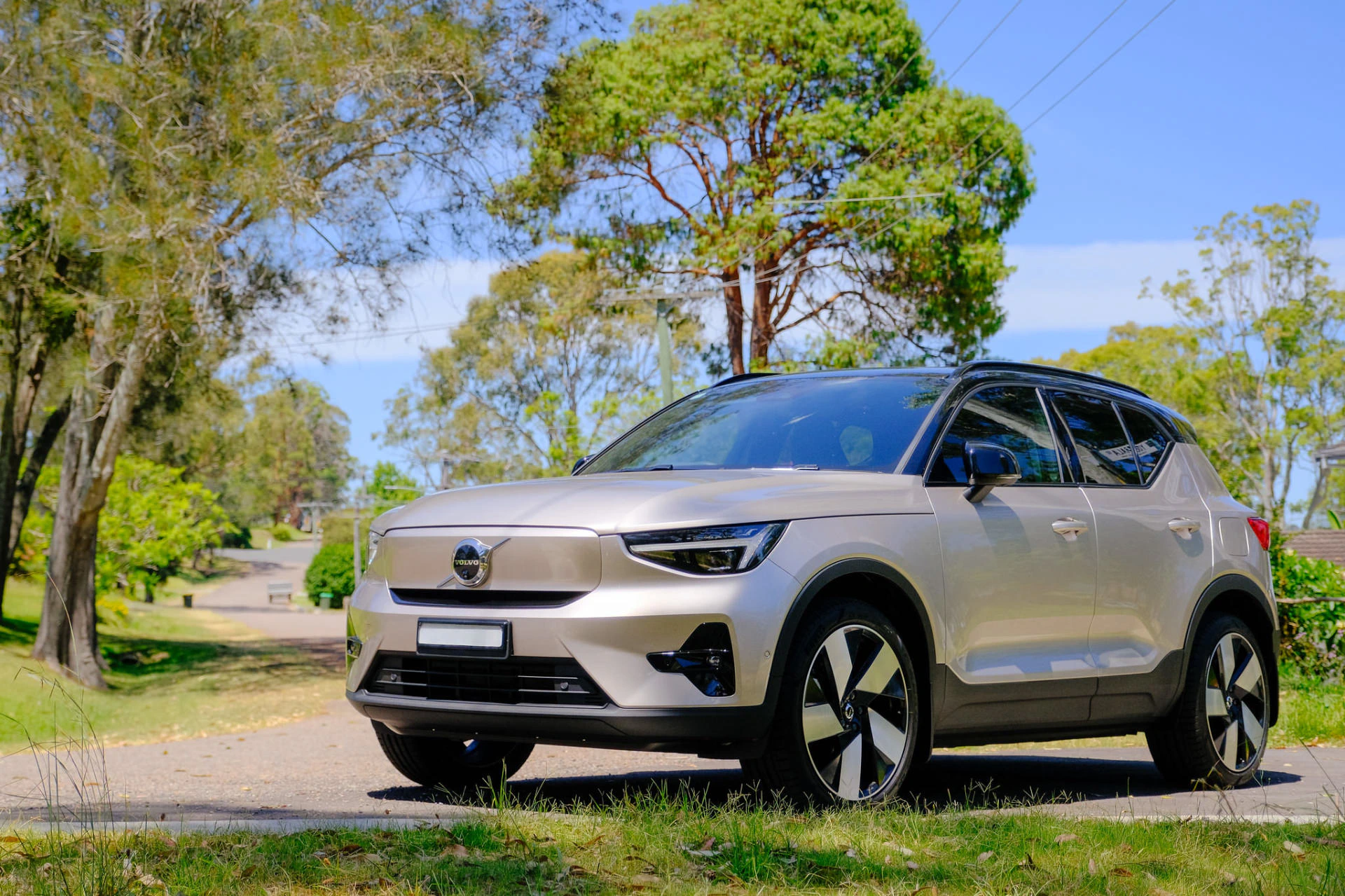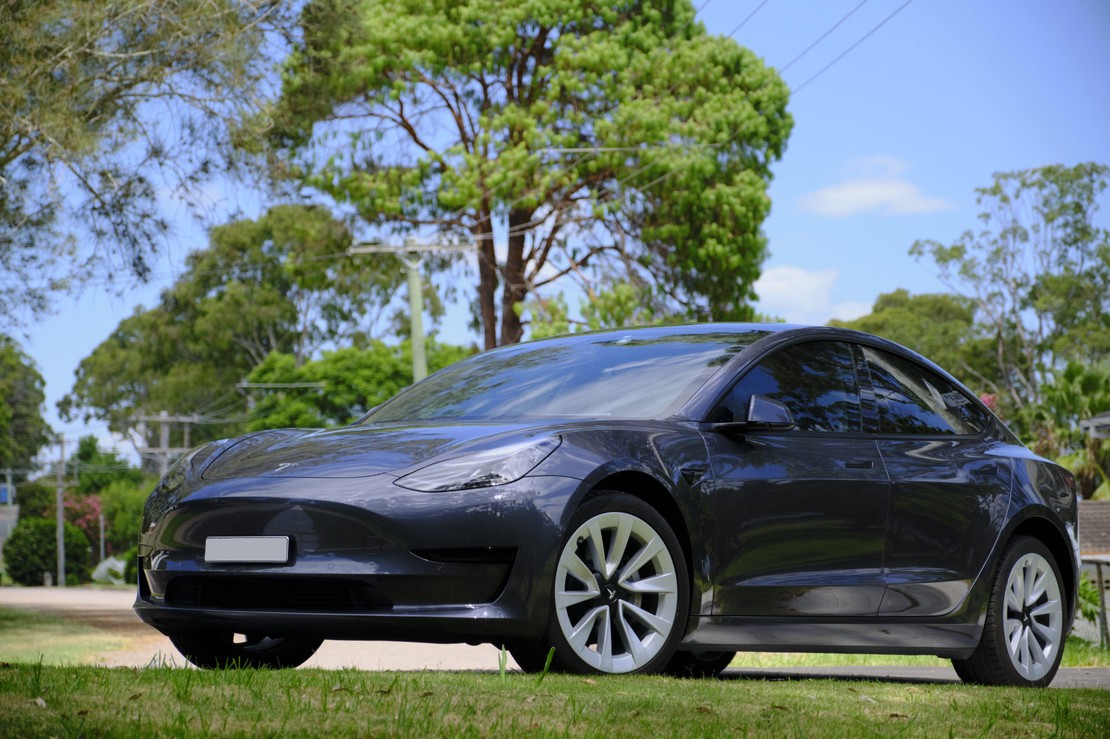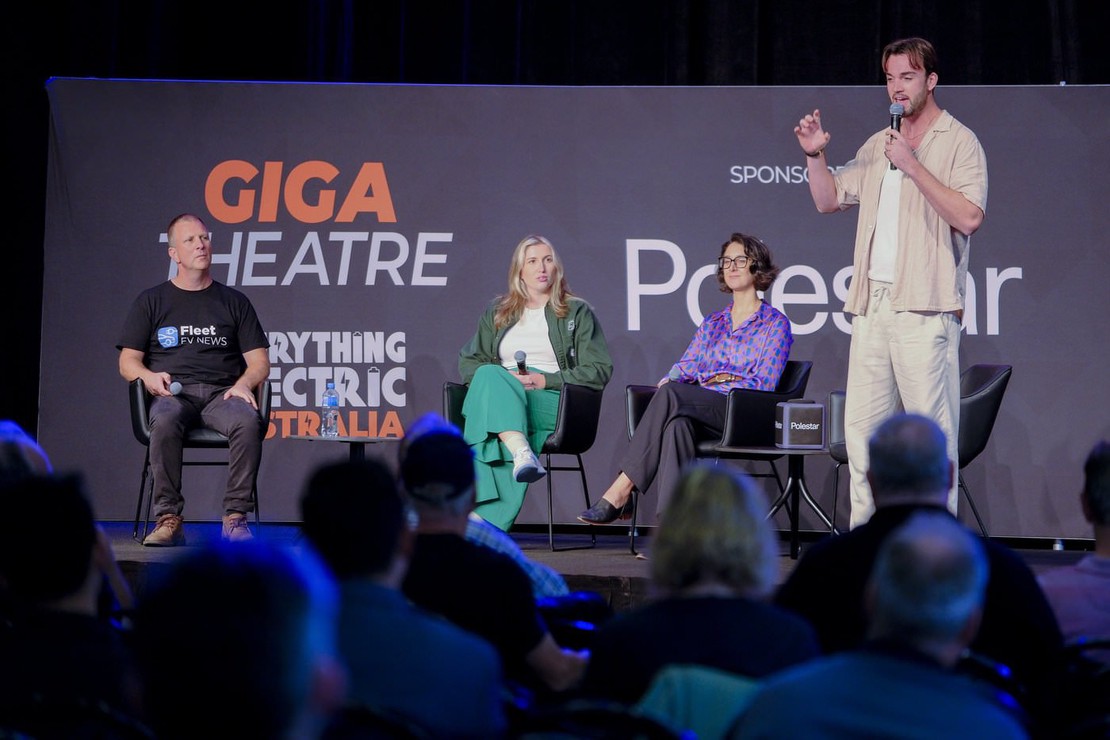
Decided to replace my Tesla Model 3 SR+ and upgrade to a Volvo XC40 Recharge Twin Ultimate (aka EX40 for MY25). This is a post where I collect my first impressions of the XC40 Recharge, and compare it to my previous Tesla M3.
That new car smell
Traded in my MY21 Tesla Model 3 SR+ for a Volvo MY24 XC40 Recharge Twin Ultimate (ex-demo). The Tesla trade-in value was on the lower end of what I had hoped for though, I could have gotten more if I had gone private. But it’s just convenient to do a dealer trade-in.
History
The Volvo XC40 model was introduced at the end of 2017 (the original Tesla Model 3 was also from 2017), and had a number of minor refreshes over the years. It has petrol, diesel and (plug-in) hybrid models, and since 2019, a battery electric model, both in front-wheel and all-wheel drive. The diesel engine got discontinued, as was the petrol AWD I believe. As you can see, the XC40 started out as Volvo Concept 40.1 is not a purpose build BEV vehicle, but rather a transition vehicle. This same Compact Modular Architecture (CMA) platform though is also used for the C40 model (which is only available as EV) and by Polestar for its Polestar 2 model, which in fact started as the Volvo Concept 40.2 . Hence why the XC40 Recharge, C40 and Polestar 2 have a transmission tunnel, which is used to house batteries, missing out on a flat floor in the back. (More about the design philosophy )
2023 saw a refresh of the MY24 XC40 Recharge version with an updated front, a new, slightly larger NMC battery and faster charging, and a new motor layout, in single rear-wheel drive or Twin all-wheel drive with Asynchronous Induction motor (110kW) in the front (which is disengaged most of the time, improving efficiency), and Synchronous Permanent Magnet (190kW) in the back. The same changes were introduced in the C40 and Polestar 2. This may well be the last refresh for the XC40 model, as Volvo is phasing out ICE cars, and they introduced a new EV-only EX line of models with the EX90 and EX30 (deliveries starting second half of 2024). These are designed from the ground up to be electric only, with the added efficiency that comes with that (efficiency, interior space).
The 2019 XC40 Recharge is by many considered their first EV, but Volvo had a limited run of the C30 battery electric vehicle in 2011, which I assume they learned a lot from. For reference, up to then, Tesla had only been manufacturing the Roadster, and debuted the Model S mid 2012.
By the way, XC stands for “Cross Country”, applying to their SUV and wagon models, having a higher stance (than their sedans).
I like the XC40’s blocky, muscular stance, broad shoulders, and its two-tone colour combo. I think the Bright Dusk and black roof is just a classy, fine looking car. Even after 6 years, with the slight tweaks on the headlights, the Thor’s hammer daylights and indicators, it still looks modern and sophisticated (I think). Most people wouldn’t notice this being an EV. The lack of grille at the front is the only giveaway. Lots of EVs, like Kias and Hyundais, BYDs, the MG4, they look too “futuristic” and they will look dated very soon.
I drove a C40 once on a NRMA EV day (for 10-15 minutes), as well as did a test drive of a 2022 Polestar 2 Performance (for 30 minutes). I rented a 2022 Single motor Polestar 2 for week (doing 761km) and a Cupra Born (as a replacement for Polestar 2) for a week (doing 2312km) while on holiday in Europe. The Polestar was a fine car, build like a tank (just like Volvo) and smooth, but the Cupra Born was a more enjoyable, fun drive. The software on the Polestar was far better than that on the Cupra Born though. And I’m not a fan of the Cupra’s looks, it’s not my thing.
Pricing
The Volvo XC40 Recharge Single motor (Plus package) starts at about AU$85.000 driveaway (significantly more than a base Tesla M3/MY RWD), while the Twin motor (incl Ultimate package) is AU$94.500 driveaway. For comparison, a Tesla MY single motor is AU$70.800 driveaway, but twin motor Performance is AU$99.300 driveaway, with optional paint options, and Advanced AutoPilot and Full Self Drive options (which you can pay for, but can’t actually use in Australia at the time of writing…). The MYP is a lot faster (top speed) than the XC40 Twin, but you get the same Tesla (interior) finish as the base model, which at this pricepoint is staggering.
The pricing of a Polestar 2 is very similar to the Volvo pricing, but with a bunch of optional packs to choose from. The disadvantage for me of Polestar is the fact they don’t do trade-ins, and you can’t service a Polestar at all Volvo dealers (only ones that are licensed), so It meant that I had to get it serviced in Sydney or Newcastle, which is an inconvenience (like having the Tesla serviced in Chatswood only) being on the Central Coast. Not that EVs need much servicing, but I did get two Tesla (warranty) services in the 2+ years I had mine.
Talking about Servicing, the Volvo comes with 5 years or 150.000km of servicing included (new windscreen wipers, break fluid, safety checks…), 8 years or 150.000km on the high-voltage battery, 5 years roadside assistance, 5 year unlimited km warranty, 4 years Digital Services data subscription, and 8 years of Volvo On Call service (with Automatic Crash Notification, Stolen Vehicle Tracking,…)
(Tesla comes with 4 years warranty, and a limited roadside assistance, 8 years for the battery. You also pay AU$10 a month for Premium Connectivity data plan after the first year)
Build
The car is build like a tank, just like any other Volvo. The doors give you a very satisfying thunk sound when closing. The dashboard is solid. The seats are comfortable, giving lots of support. The tailgate comes down reassuringly. You’re not skimping on anything just because it’s an EV. It is day and night difference to my Tesla M3. Tesla’s efficiency comes at the cost of a solid, quality build. It is 500kg lighter, which means you get lighter, simpler seats, a frameless door, a very light A-pillar cover (which you can simply press in) for example, a single power strut which struggles to close the booth, a light paint job,… The XC40 on the other hand oozes quality. People tend to compare Tesla to other luxury brands like BMW, Audi, Volvo,…, but really they shouldn’t, you can’t.
Drive
The drive is how you’d expect a Volvo to drive, I suppose. It’s lovely, relaxed, refined. Even more so as an EV. I missed the higher seating position of an SUV in the M3. Having a better view of traffic around you, makes you feel more relaxed. I didn’t know that was such a big deal (for me), until I got back into an SUV, vs a sedan driving position. It’s also easier, effortless to get in/out.
One pedal driving is as good as on the Tesla. Although during my testdrive, I didn’t think so. But maybe I didn’t set it up correctly then, or an OTA update changed that. Once you’re used to one pedal driving, you can’t go back. Regen is indicated on the right hand side of the instrument cluster.
The XC40 eats up any bumps and potholes it encounters. You glide across speedbumps. The M3 would pass on any bump straight up your spine. But the M3 is more fun cornering for sure, doing Old Pacific Highway, or Kangaroo Valley. I’ll be doing that slower in the XC40. But I’d also open up the sunroof and let in the sound of birds and cicadas. (Opening a window is not quite the same). Cornering is not the XC40’s forte, as you’d expect of a heavy SUV, but as you get out of the corner, and put the pedal down, it goes… Just like at traffic lights.
Efficiency though is far lower than the M3. The XC40 is a bit of a brick (Cx 0.32), vs the slick and slippery M3 (Cx 0.23). It’s also far heavier (nearly 500kg). My average after 2+ years was 13.4kWh/100km (or 7.4km/kWh) on the M3. After 5000km on the XC40, I’m at 18.0kWh/100km (or 5.55km/kWh). My fortnightly office trip from Central Coast to Darling Harbour is about 100km, and that’s 17.4kWh/100km (5.7km/kWh) at an 81km/h average (about half the trip is at 110km/h highway speed). This would give me 410km - 445km on the 78kWh XC40 battery. The bigger XC40 battery also means I can only trickle charge 20% overnight, vs 30% on the M3 54kWh battery. Not a big deal for me. But yes, a smaller battery and more efficiency made the M3 cheaper to run than the XC40. If only I had solar panels, it wouldn’t matter.
Ground clearance of the Recharge is 175mm, compared to 211mm of the XC40 petrol versions, or 140mm for the Tesla M3. The XC40 Recharge has an official wading depth of 45cm, as documented by Volvo. Tesla M3 doesn’t have an official wading depth which didn’t stop people driving through water 60cm deep or more, probably voiding their warranty if anything went wrong.
There is no eco or sport mode. There is an offroad mode though, providing enhanced all-wheel drive, and hill descent control, available at up to 40km/h. Here’s a great overview of it’s offroad capabilities .
Side mirrors have boomerang blind spot indicators, and are auto-dimming. The XC40 has all the expected tech safety features, including Pilot Assist, and a 360 bird-eye view using four of its cameras. It’s not immune to ghost-breaking, just like on the M3, although it doesn’t break as hard as on the M3.
Interior
I love the interior. It’s understated. They call it Swedish minimalism. Compared to Tesla’s minimalism, it isn’t. But compared to other European or Asian brands, sure is. I drove a BMW i4 recently, and compared to that, the XC40 is an oasis of calm and elegance .
Seats are comfortable, supportive, superior to the Tesla M3 seats. Plastics used are decent, solid. The steering wheel is chunky, with the right buttons at your fingertips. It has classic stalks, which feel solid to use (in contrast to both the Tesla M3’s and even BMW i4’s). I say classic, as it has all possible headlights and wiper settings right there on the stalks. No need to go through a menu to change the wiper speed.
The 9” center screen is responsive, and has a good resolution. The wireless charging pad is a bit finicky (though it could be my iPhone case).
The glove box has, what the British call, a curry hook, to hang up your takeaway food bag. You can remotely fold down the backseats’ headrests to get a better view out the back.
The Ultimate edition has topography inspired, translucent back-lit inlays that create a soothing glow in the cabin, when the lights turn on. Love that, so different to anything else out there.
The car has these anchor points in the roof, which allows it to attach accessories, like a divider net, between the booth and backseat, or between the front seats and the back when backseats are folded down. Handy when taking the dog in the back.
Software
The Volvo uses Android Automotive OS (AAOS), a variation of Google’s Android operating system, tailored for its use in vehicle dashboards. Introduced in March 2017, the platform was developed by Google and Intel, together with car manufacturers such as Volvo and Audi. It comes with Google Maps for navigation, both on the 9” center screen and the instrument cluster. Google Maps will also tell you your expected SOC (state of charge) at the destination, just like with Tesla. And it is very accurate And a dedicated charging shortcut to show nearby chargers.
The instrument cluster shows speedometer on the left, and energy use/regen dial on the right, with a maps display in the middle. The instrument cluster graphics are elegant and minimal, in a calm blue colour palette.
You have access to the Google Play store where you can add AAOS designated apps, like Audible, or Prime Video to watch movies or TV series (when parked), just like in the Tesla, though on a smaller screen. The selection isn’t big for AAOS apps, but there’s Waze, YouTube, Spotify, PlugShare, games, and a full browser, where you can load ABC iView or SBSonDemand. Come to think of it, more apps than you can get on Tesla.
Currently, Volvo uses Singtel as their mobile provider. Not Optus, but its parent company, Singtel. So yes, it looks like your connected from Singapore, for example in the Prime app (“You on holiday?”, but it still streams). I was told by the dealer Volvo was looking into getting an actual local partner for their mobile connection. If you want to use Disney+ from the browser, you will need to hotspot from your phone as Disney+ blocks roaming.
On the center console, there’s a physical, backlit, homescreen button (where a 3 seconds press gives you cleaning mode, and 20 seconds restarts the system), that brings you to a focused home screen with four sections, with each section showing its last used app. There’s also a separate app overview screen like on a tablet. Then there’s also the car functions screen which seems separate from AAOS. This is where you change audio settings, preferences etc. It has a dedicated range app/screen, showing a maximum (hypermiling, turning everything off) and minimum (flooring it) expected range and current expected range. It’s good to know the absolute minimum range you still have. It also has an outdoor air quality app.
One of the AAOS 4 homescreen options is (wired) Apple CarPlay. You hook up your phone to the CarPlay designated USB-C port, the other port is for power only. I love the convenience of CarPlay, the familiarity. But only certain iOS apps work on CarPlay. It is perfect for a 9” screen though.
I wrote a bit more about CarPlay here .
Overal, the software works well, it’s simple and familiar. To be honest, Polestar’s integration of AAOS is neater and more modern looking, true.
I believe I’ve had three OTA updates so far over the last three months, which is nice.
What is missing though is Android Auto support, pretty strange considering the AAOS basis this runs on. I’m sure there are more Android Auto apps available than AAOS apps.
App
The car also has an app, for iOS and I assume for Android. It allows you to remotely unlock/lock your car, turn on or schedule the air conditioning, and schedule charging. It shows the location of your car, SOC, temperature (outdoor only), the odometer and average energy consumption, car details (VIN) and car software version. It has shortcuts to get assistance, and shows your current subscriptions (connected services). I wish it allowed for battery preconditioning, would show lifetime charging stats, differentiated between home and public chargers. Tesla’s app in far superior in comparison.
Sunroof
I actually hated the M3 sunroof. As driver, you don’t get to enjoy the view. Sure it makes the interior lighter. It also burns the top of your skull in the Sydney sun. Even with the (optional) shade attached, you could still feel the sun on top of your head. The car parked at home would get 56C. The interior overheating protection is supposed to kick in at 40C, but if the M3 was in a deep sleep (not sure, but when parked for 24h?), that wouldn’t kick in.
The XC40 has a traditional moonroof (I didn’t know there was such a thing as moonroof vs sunroof), with a build in shade. It can vent, or it can open up the front half. Not something you’d use in Sydney summer time (except to quickly vent hot air), but when Sydney winter time comes, I expect to open it up for sure. The operation is with capacitive swiping and tapping, and needs a bit of getting used to. C40 and Polestar 2’s roofs don’t open (as such, they’re sunroofs). So far, the hottest it got inside parked at home was 42C.
Conclusion
I love my XC40. It’s practical, it’s fast, it’s comfortable, it’s safe, it’s efficient enough. It’s a Volvo. It’s a keeper.
EDIT: I’ve been told that a moonroof is a sunroof with a glass panel, and a sunroof is a metal panel (which slide open)?
EDIT: Start of 2024, Volvo announced a namechange of the XC40 Recharge to just EX40, in line with the EX90 and EX30 EV only models, which lack the Recharge monniker. The petrol versions remain XC40.
EDIT: I called my Tesla, Thelma. My Volvo is called Greta.

